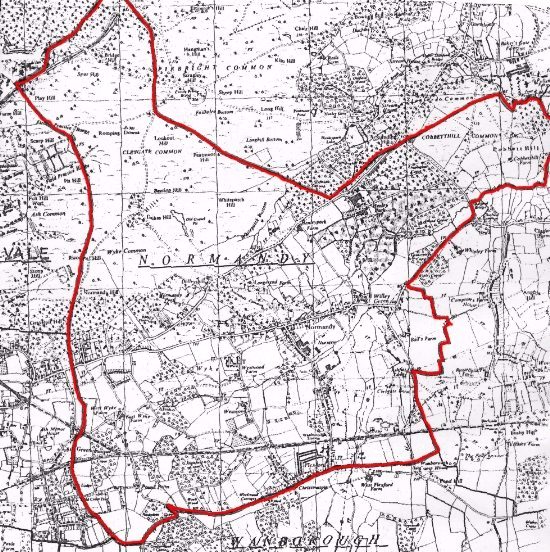| The Manor of Cleygate
From medieval times, until various reforms were enacted during the 19th
century, the main unit of government in rural areas was the Manor Court.
Manors varied greatly in size, some being confined to a single parish whilst
others extended over several. There was very little correspondence between
Manors and Ecclesiastical parishes. A large part of what is now the Civil
Parish of Normandy was included within the boundaries of the Manor of Cleygate.
Although no map or plan of the Manor has so far been found it has been
possible to roughly estimate its boundaries. At its greatest extent the
Manor probably reached north as far as the Basingstoke Canal. On the east
it bordered the Manor of Pirbright where the boundary ran over Standing
Hill east of Henley Park. It stretched south as far as the boundary with
Wanborough Manor which is now represented by Flexford Road. On the west
it marched with the other main constituent of the present Normandy parish,
the Manor of Wyke. There were also outlying portions, represented for example
by land in Ash, recognised now as "Longacre".
This Manor was of comparatively late foundation having been carved out
of the much more ancient Manor of Henley in the 14th century. The first
written reference was when in 1399 a grant was made to Richard Rayle and
Nicholas Churchill of "lands called Cleygate lying at Henley".
The earliest mention as a Manor occurs during the reign of Henry VI who
granted it to his uterine brother Jasper, Earl of Pembroke. He was attainted
among Lancastrians by Edward IV and his estates were forfeited.
Richard III gave custody of the Manor to William Mistelbrooke for life.
The Manor was returned into the possession of Jasper Tudor, then Duke of
Bedford, on the reversal of his attainder in 1485. From then on the Manor
passed through various hands often reverting to the Crown.
The last private Lord of the Manor was Mrs Rose Mangles who sold the
Manor to the War Department in 1876. By that time much of the land had
been sold off to private individuals and that remaining, amounting to about
1200 acres, lay mainly north of the Pirbright Road and now forms part of
Ash Ranges. As the War Department wished to exclude the public from its
acquisition the remaining Commoners who had the right to graze livestock,
extract sand and gravel and dig peat had to be compensated and negotiations
continued and were not finally settled until the 1930s.
The powers of the Lord of the Manor were gradually eroded over the years
until a major reform of land tenure was passed in 1925 when the title became
purely nominal. In its heyday the Manor Court dealt with matters both judicial
and administrative. Each Court had two aspects: the Court Baron was concerned
with administrative matters and disputes between tenants and the Court
Leet, also called the View of Frankpledge covered election of officials
and disturbances of the Peace. Grave offences such as murder were passed
to the County Court of Assize.
The business of the Court was conducted by the Steward on behalf of
the Lord of the Manor who in the case of Cleygate was almost always an
absentee landlord. The Manor of Cleygate originally contained two tithings
called Frimelsworth and Henley. A tithing was a group of nominally ten
households who was held responsible for its members' good conduct. Their
elected representative was a decenar or tithingman. In the reign of Queen
Elizabeth I the tithingman for Frimelsworth rejoiced in the name of John
Plonker! All tenants were required to attend the Court. Permitted absences
were called Essoins. Others were called Defaults and were punished by a
fine. A number of tenants usually ten or twelve were sworn to act as a
jury called The Homage. By 1609 the tithings had been amalgamated under
one tithingman and in 1620 the tithingman for Cleygate Manor was called
"The decenar in this place".
Throughout the period covered by the surviving records the conduct of
the Manor, whilst mainly concerned with the transfer of holdings and complaints
such as obstructions and blocked ditches, was occasionally disturbed by
reports of cattle rustling and fights between tenants, now and then resulting
in blood being shed.

- This map illustrates the Normandy Parish Boundary at the
present time, but it does serve to indicate the huge area of the ancient
Manor of Cleygate
Jack Kinder
- References:
- Records of the Manor Court of Cleygate
The Local Historian's Encyclopedia, John Richardson, Historical Publications
Ltd; 1993
-
- Wikipedia links
- Manor
Court
- Court
Baron
- Lord
of the Manor
- Court
Leet
- County Court of Assize
- Jasper
Tudor
|